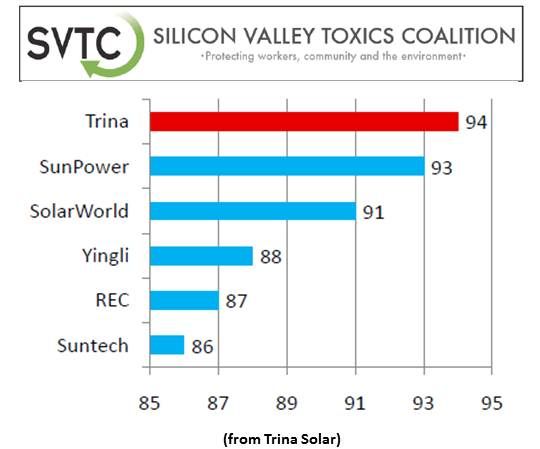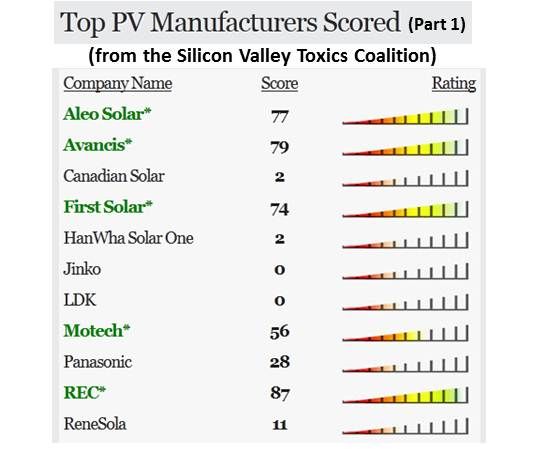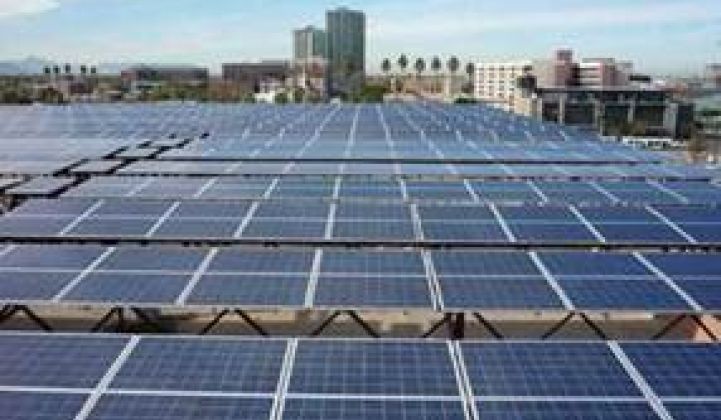The Silicon Valley Toxics Coalition (SVTC) 2012 Solar Scorecard, intended to push the photovoltaic (PV) panel manufacturing industry to do the right thing, was just released.
Compelling an industry struggling to weather economic, political and technological upheaval is challenging, but the SVTC is making progress. In its first year, the scorecard got fourteen responses, representing 24 percent of the PV industry market share, from the approximately 200 queried companies. Last year, it got 46.6 percent. This year the number of queries was pared to 116 and fifteen responses covered 51 percent of the market.
In defiance of clichés about Chinese manufacturers, China’s Trina Solar, which manufactured 1,702 megawatts in 2011, was first on the scorecard, with 94 points out of a possible 100. It got perfect scores in Extended Producer Responsibility (25), Worker Rights, Health, and Safety (20) and Sustainable Design and Life Cycle Assessment (15) and high scores in Chemical Use (16 of 20) and Supply Chains (18 of 20).
Trina’s high ranking “flies in the face of a lot of what American consumers have heard about how business is done and how products are produced in China,” said Trina Solar Americas Director of Marketing Mike Grunow.
“We are one of the two industry leaders [with Yingli Solar] and we are doing all this while maintaining cost leadership,” Grunow said. Trina “would not make such investments,” he added,” if they didn’t make sense from a return on total capital perspective.”
Industry observers are expecting “a solar shakeout, a consolidation, where we go from 100-plus suppliers to fewer than ten key ones,” Grunow said. “We think the SVTC award should reinforce the concept that we are stewards of our environment as well as stewards of our balance sheet.”

SunPower, which manufactured 837 megawatts in 2011 at facilities in Malaysia, Mexico, the Philippines and the U.S., was second, with 93 points. SolarWorld, which made an estimated 800 megawatts at U.S. and German facilities, was third, with 91 points. Chinese manufacturer Yingli Solar, which produced 1,600 megawatts, was fourth, with 88 points. And REC, which manufactured 700 megawatts in 2011 at its Singapore facility, rounded out the top five with 87 points.
The bottom five were all survey non-responders. China’s Jinko and LDK scored zeros. Canadian Solar (China), HanWha Solar One (Korea) and Schott (Germany, China, U.S. and the Czech Republic) each got two points for having some information on their website.
“We give them every opportunity to respond,” said SVTC Campaign Director Lauren Ornelas. “It seems some are more concerned about how well they would do than in being transparent.” In an effort to drive participation, Ornelas said, SVTC this year began using information from the companies’ websites and scoring them even if they didn’t respond.
That, said San Jose State University Assistant Professor of Sustainable Energy Resources Dustin Mulvaney, “is probably the most important aspect of this survey.” No longer can companies like Jinko and LDK “hide behind their ‘did not reply’ instead of actually engaging,” he said.
“We’re talking about an industry that has a reputation of being green,” explained Ornelas. The point of the scorecard, she said, is “making sure they live up to their reputation.” SVTC supports the solar industry, Ornelas insisted. “We just want to make sure the industry confronts these issues right now instead of looking back in twenty years and asking why they didn’t think about them sooner.”


PV panels’ expected 30-year lifespans means recycling won’t be a big issue for another two decades, but the SVTC scorecard allots 25 points, the biggest single portion of its score, for a company’s take-back/recycling program. “When you have millions of solar panels coming off roofs,” Ornelas explained, “that’s not the time to say, ‘Oh my gosh, now we have a toxic waste issue.’ We want them to start thinking about it now.”
The European Union’s PV Cycle program led the way with a voluntary “pre-pay” fund that will cover the cost of recycling whether or not the manufacturer is around in 30 years, noted Ornelas. But SVTC is pushing for a mandatory program because it has seen that voluntary e-waste programs are inadequate.
Worker health and safety issues, at twenty possible points, were almost as important in the rankings. “We don’t think you can have a green industry,” Ornelas said, “unless it matters how workers are treated.”
Chemical use is another twenty-point issue. Mulvaney noted that cadmium used in CdTe thin film panels, selenium used in CIGS thin film panels and lead used in silicon panels are the three top toxicity concerns, but many other chemicals used in processing are also hazardous. Obtaining information about how chemicals are used and disposed of is very difficult, Mulvaney said, so SVTC chose to reward participation.
“We gave them points just because they told us they had taken federal or state tests,” Mulvaney explained. “The direction the scorecard is headed is more external evaluations, not relying so much on companies self-reporting, and actually getting at data that reveals practices and performance.”
Encouraging participation, Ornelas said, seems to be slowly turning the industry toward greater disclosure. Both Trina and SunPower, she noted, were non-responders in previous years. But “solar companies are looking at the questions we are asking and that is guiding them,” she concluded. “What solar company wouldn’t want to score high in social responsibility? That’s what they’re all about.”



